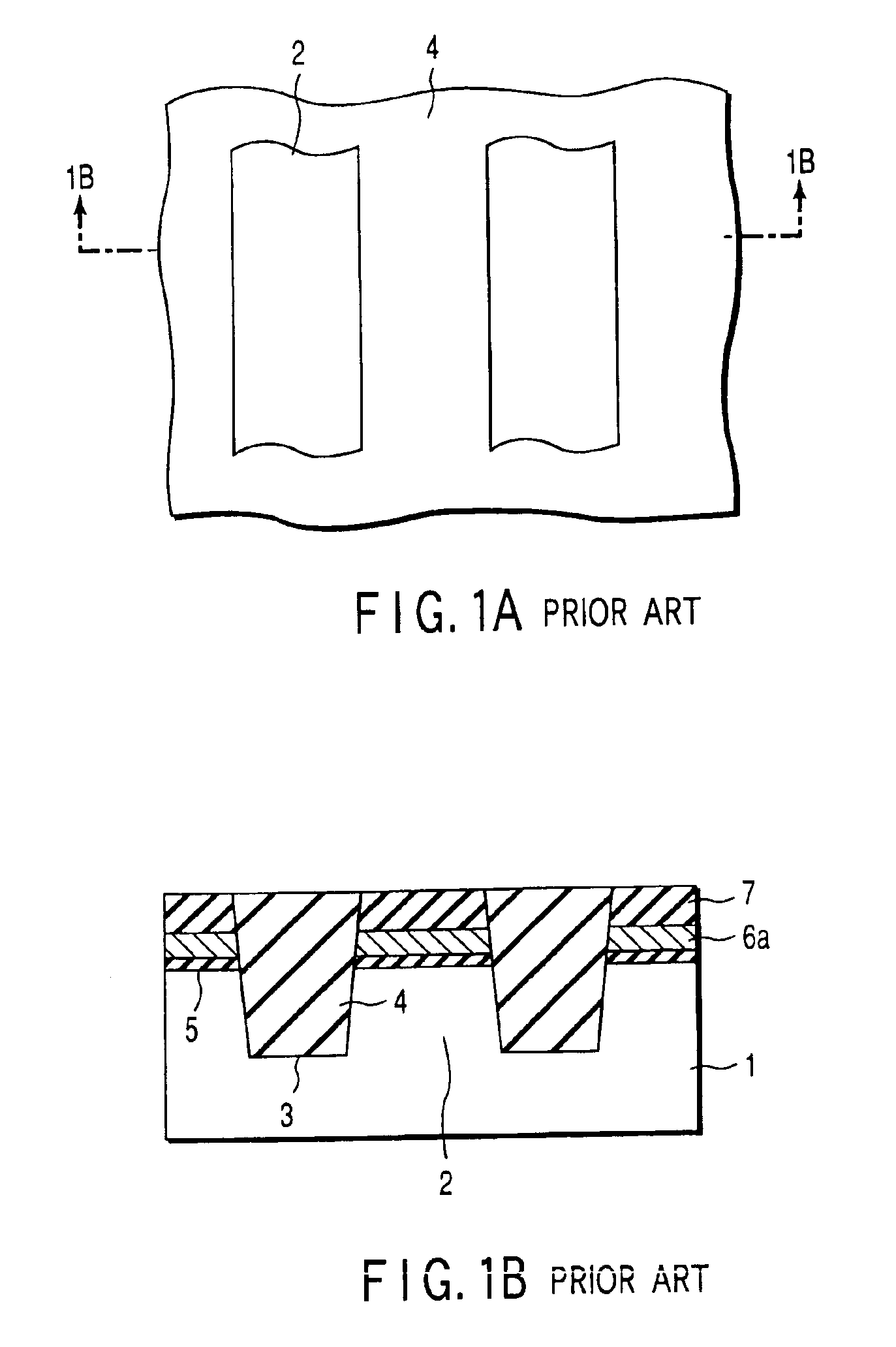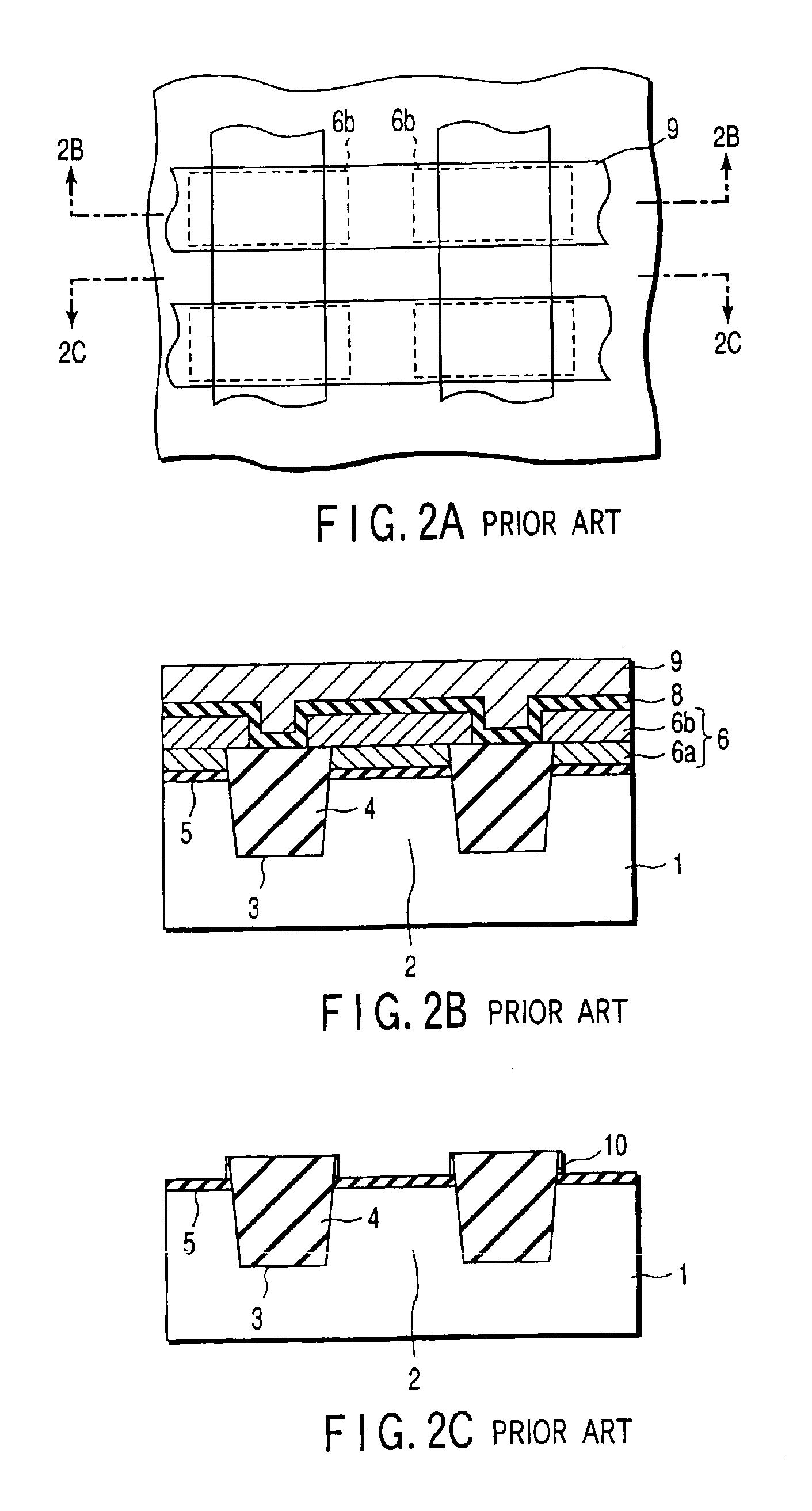Method of manufacturing semiconductor device using STI technique
a manufacturing method and semiconductor technology, applied in the field of semiconductor devices, can solve the problems of likely short circuit between floating gate electrodes
- Summary
- Abstract
- Description
- Claims
- Application Information
AI Technical Summary
Benefits of technology
Problems solved by technology
Method used
Image
Examples
first embodiment
[0038]FIG. 3 is a plan view schematically showing the structure of the memory array portion of the NAND type EEPROM according to the present invention. FIG. 4A is a cross-sectional view taken along the line 4A-4A of the structure shown in FIG. 3, while FIG. 4B is a cross-sectional view taken along the line 4B—4B of the structure shown in FIG. 3.
[0039]Referring to the structure shown in FIGS. 3, 4A and 4B, a groove 13a for device isolating is formed by making use of an STI technique in one of the main surfaces of a p-type silicon substrate 11. This groove 13a is filled therein with a first device isolating insulation film 14a and a second device isolating insulation film 14b, both constituting a device isolating region. The element region 12 surrounded by these first device isolating insulation films 14a and second device isolating insulation films 14b is formed stripe-like, on which a gate insulation film (tunnel insulation film) 15 and a floating gate electrode 16 are successively ...
second embodiment
[0060]Next, the present invention will be explained. In this embodiment, the present invention is applied to the manufacture of a flash memory.
[0061]FIGS. 7A to 7H are views schematically showing the manufacturing process of the flash memory according to the second embodiment of the present invention; wherein FIGS. 7A, 7B, 7D and 7E are cross-sectional views each showing the manufacturing process; FIG. 7C is an enlarged partial cross-sectional view showing a portion of FIG. 7B; FIG. 7F is a plan view showing an accomplished structure; FIG. 7G is a cross-sectional view taken along the line 7G—7G of the structure shown in FIG. 7F; and FIG. 7H is a cross-sectional view taken along the line 7H—7H of the structure shown in FIG. 7F.
[0062]As shown in FIG. 7A, a silicon substrate 11 is heated in an oxygen gas atmosphere at a temperature of 800° C. to form a silicon oxide film 15 having a thickness of 10 nm on one of the main surfaces of the silicon substrate 11, the silicon oxide film 15 be...
third embodiment
[0075]Next, a third embodiment according to the present invention will be explained.
[0076]FIGS. 9A to 9C are cross-sectional views schematically illustrating the manufacturing process of the flash memory according to the third embodiment of the present invention. This third embodiment is almost the same as the second embodiment except that the method of forming the silicon oxide film 44a differs from that of the second embodiment.
[0077]Namely, first of all, in the same manner as explained in the second embodiment, a structure shown in FIG. 7A is obtained. Then, as shown in FIG. 9A, a silicon oxide film 44a having a film thickness of 20 nm is deposited on the surface of the structure by means of low pressure TEOS / O3 method at a temperature of 700° C. (alternatively, plasma CVD method at 400° C.). Then, as shown in FIG. 9B, the entire surface is subjected to RIE to remove the silicon oxide film 44a located outside the groove 43a, thus selectively leaving only the portion of the silico...
PUM
 Login to View More
Login to View More Abstract
Description
Claims
Application Information
 Login to View More
Login to View More - R&D
- Intellectual Property
- Life Sciences
- Materials
- Tech Scout
- Unparalleled Data Quality
- Higher Quality Content
- 60% Fewer Hallucinations
Browse by: Latest US Patents, China's latest patents, Technical Efficacy Thesaurus, Application Domain, Technology Topic, Popular Technical Reports.
© 2025 PatSnap. All rights reserved.Legal|Privacy policy|Modern Slavery Act Transparency Statement|Sitemap|About US| Contact US: help@patsnap.com



